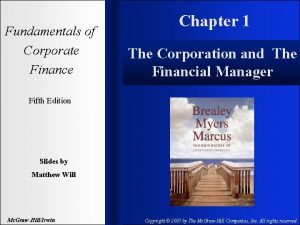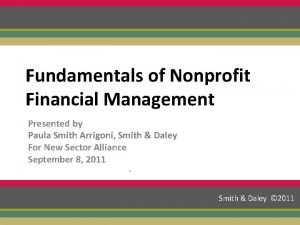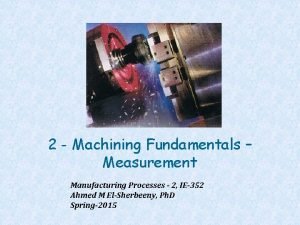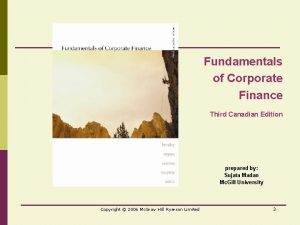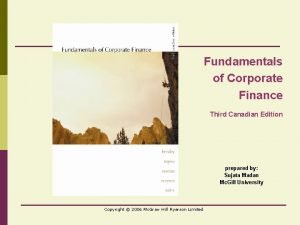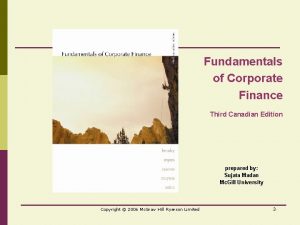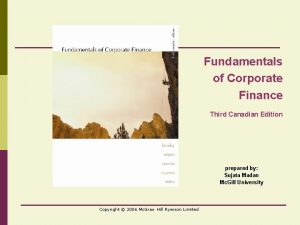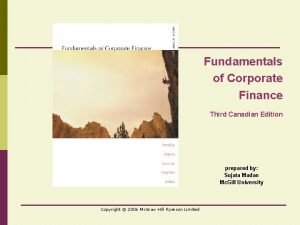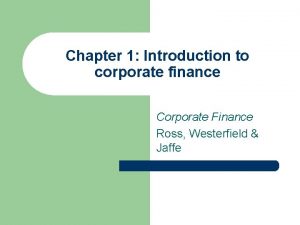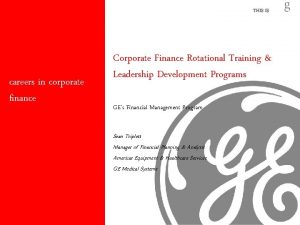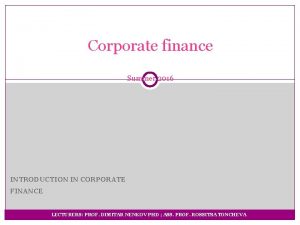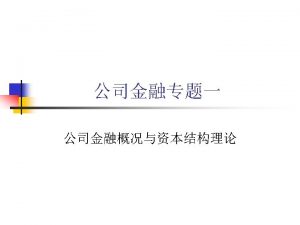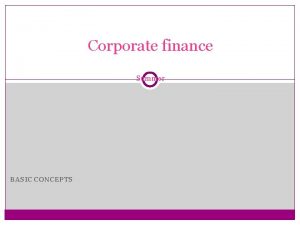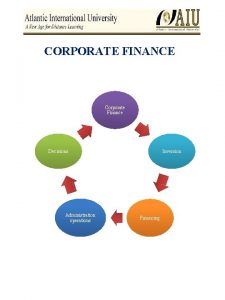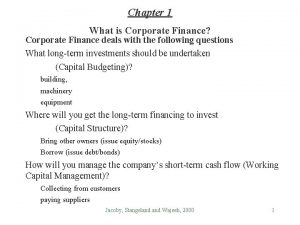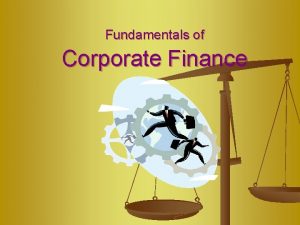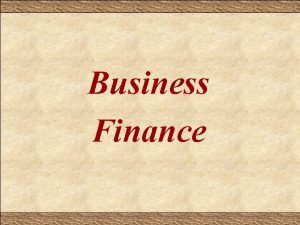Fundamentals of Corporate Finance Third Canadian Edition prepared


























- Slides: 26

Fundamentals of Corporate Finance Third Canadian Edition prepared by: Sujata Madan Mc. Gill University Copyright © 2006 Mc. Graw Hill Ryerson Limited

Chapter 10 Introduction to Risk, Return and the Opportunity Cost of Capital n Rates of Return: A Review n 79 Years of Capital Market History n Measuring Risk n Risk and Diversification n Thinking about Risk Copyright © 2006 Mc. Graw Hill Ryerson Limited 2

Rates of Return: A Review n. Measuring w Rate of Return The total return on an investment is made up of: § § Income (dividend or interest payments). Capital gains (or losses). Percentage Return = Capital Gain + Dividend Initial share Price Copyright © 2006 Mc. Graw Hill Ryerson Limited 3

Rates of Return: A Review Copyright © 2006 Mc. Graw Hill Ryerson Limited 4

79 Years of Capital Market History n Market index: Measure of the investment performance of the overall market w S&P/TSX Composite Index - Index of the investment performance of a portfolio of the major stocks listed on the Toronto Stock Exchange. w Dow Jones Industrial Average - Value of a portfolio holding one share in each of 30 large industrial firms. Copyright © 2006 Mc. Graw Hill Ryerson Limited 5

79 Years of Capital Market History Value of a $1 investment made in 1925: Copyright © 2006 Mc. Graw Hill Ryerson Limited 6

79 Years of Capital Market History n. Average returns on T-bills, government bonds and common stocks (1926 -2004) : Average Annual Portfolio Rate of Return Treasury Bills 4. 7% Gov’t Bonds 6. 4% Common Stocks 11. 4% Copyright © 2006 Mc. Graw Hill Ryerson Limited Average Risk Premium* 1. 7%capitals 6. 7%capitals 7

79 Years of Capital Market History n Can the past tell us about the future? w The historical record shows that investors have received a risk premium for holding risky assets. Rate of Return on Any Security = Interest Rate on T-bills Copyright © 2006 Mc. Graw Hill Ryerson Limited + Market Risk Premium 8

Measuring Risk n Variance and Standard Deviation w Variance: § w Standard Deviation § w The average value of squared deviations from the mean. The square root of the variance. Both variance and standard deviation are measures of volatility. Copyright © 2006 Mc. Graw Hill Ryerson Limited 9

Measuring Risk n Coin Toss game w 2 coins are flipped For each head, you get 20% For each tail, you lose 10% w Possible outcomes: w w § § HH: 20+20=40 HT: 20 -10= 10 TH: -10+20=10 TT: -10 -10=-20 Copyright © 2006 Mc. Graw Hill Ryerson Limited 10

Measuring Risk n Calculating Standard Deviation for the Coin Toss Game Copyright © 2006 Mc. Graw Hill Ryerson Limited 11

Measuring Risk n. Standard w Deviation for Various Securities Average rates of return and standard deviation for various investment classes (1926 -2004): Average Annual Average Standard Portfolio Rate of Return Risk Premium Deviation Treasury Bills 4. 7% 4. 2% Gov’t Bonds 6. 4% 1. 7%capitals 9. 0% Common Stocks 11. 4% 6. 7%capitals 18. 6% Copyright © 2006 Mc. Graw Hill Ryerson Limited 12

Measuring Risk n. Standard w Deviation for Various Securities Notice the risk-return trade-off: § § § T-bills have the lowest average rate of return, and the lowest level of volatility. Stocks have the highest average rate of return and the highest level of volatility. Bonds are in the middle. Copyright © 2006 Mc. Graw Hill Ryerson Limited 13

Risk and Diversification n Definitions w Diversification: Strategy designed to reduce risk by spreading the portfolio across many investments. w Unique risk: Risk factors affecting only that firm. Also called diversifiable risk. w Market risk: Economy-wide sources of risk that affect the overall stock market. Also called systematic risk. Copyright © 2006 Mc. Graw Hill Ryerson Limited 14

Risk and Diversification n. Diversification w Which stock would you pick? Scenario Probability Recession 1/3 20. 0% Normal 1/3 3. 0% Boom 1/3 -20. 0% Rate of Return Auto Stock Gold Stock -8. 0% 5. 0% 18. 0% Expected Return 5. 0% 1. 0% Copyright © 2006 Mc. Graw Hill Ryerson Limited Standard Deviation 10. 6% 15

Risk and Diversification n. Diversification w For a two-asset portfolio: Portfolio Rate of return ( ( ) ) of portfolio x rate of return = fraction st st in 1 asset of portfolio x rate of return + fraction nd nd in 2 asset on 2 Copyright © 2006 Mc. Graw Hill Ryerson Limited asset 16

Risk and Diversification n. Diversification w Rate of return for a portfolio comprising 75% auto stock and 25% gold: Scenario Probability Recession 1/3 -1. 0% Normal 1/3 4. 5% Boom 1/3 8. 5% Rate of Return Auto Stock Gold Stock -8. 0% Portfolio 20. 0% 5. 0% 3. 0% 18. 0% -20. 0% Expected Return Copyright © 20065. 0% Mc. Graw Hill Ryerson Limited 4. 0% 17

Risk and Diversification n. Diversification w Addition of the gold stock stabilizes the returns on the portfolio. w Diversification reduces risk because the assets in the portfolio do not move in exact lock step with each other. § When one stock is doing poorly, the other is doing well, helping to offset the negative impact on return of the stock with the poorer performance. Copyright © 2006 Mc. Graw Hill Ryerson Limited 18

Risk and Diversification n. Correlation Coefficient w A measure of how closely two variables move together. w The correlation coefficient is always a number between -1 and +1. Copyright © 2006 Mc. Graw Hill Ryerson Limited 19

Risk and Diversification n. Correlation § Coefficient > 0 positive correlation variables move in the same direction. § < 0 negative correlation variables move in the opposite direction. § = 0 no correlation Copyright © 2006 Mc. Graw Hill Ryerson Limited 20

Risk and Diversification n. Market Risk Versus Unique Risk w If you hold two stocks with a correlation coefficient less than 1, then the risk of the portfolio can be reduced below the risk of holding either stock by itself. w Adding stocks to the portfolio, decreases the risk of the portfolio. w How much can you decrease the portfolio risk? Copyright © 2006 Mc. Graw Hill Ryerson Limited 21

Risk and Diversification Portfolio Standard Deviation Diversification Reduces Risk 16 14 12 10 8 6 4 2 0 Unique Risk Market Risk 0 5 10 15 20 25 30 Number of Securities Copyright © 2006 Mc. Graw Hill Ryerson Limited 22

Risk and Diversification n. Market Risk Versus Unique Risk w You cannot eliminate all risk from a portfolio by adding securities. w Typically, once you get beyond 15 stocks, adding more stocks does very little to reduce the risk of the portfolio. w The risk that cannot be diversified away is called market risk. w For a reasonably well diversified portfolio, only market risk matters. Copyright © 2006 Mc. Graw Hill Ryerson Limited 23

Thinking about Risk n 3 w Key Messages about Risk Some risks look big and dangerous but are really diversifiable. § w Market risks are macro risks § w Unique risk can be minimized by creating a diversified portfolio. Example: changes in interest rates, industrial production, inflation, exchange rates and energy cost. Risk can be measured Copyright © 2006 Mc. Graw Hill Ryerson Limited 24

Summary of Chapter 10 w Standard deviation and variance are measures of risk. w Diversification reduces risk because stocks do not move in exact lock step, meaning that poor performance by one stock can be offset by strong performance by another. w Correlation coefficient is a measure of how two variables move with respect to each other. Copyright © 2006 Mc. Graw Hill Ryerson Limited 25

Summary of Chapter 10 w Risk which can be eliminated by diversification is known as unique risk. w Risk which cannot be eliminated by diversification is called market risk. w For a well-diversified portfolio, only market risk matters. Copyright © 2006 Mc. Graw Hill Ryerson Limited 26
 Fundamentals of corporate finance canadian edition
Fundamentals of corporate finance canadian edition Fundamentals of corporate finance, third canadian edition
Fundamentals of corporate finance, third canadian edition Fundamentals of corporate finance fifth edition
Fundamentals of corporate finance fifth edition Fundamentals of corporate finance 6th edition
Fundamentals of corporate finance 6th edition Fundamentals of corporate finance chapter 6 solutions
Fundamentals of corporate finance chapter 6 solutions Fundamentals of corporate finance, chapter 1
Fundamentals of corporate finance, chapter 1 Fundamentals of corporate finance, chapter 1
Fundamentals of corporate finance, chapter 1 Objective of corporate finance
Objective of corporate finance Corporate finance tenth edition
Corporate finance tenth edition Corporate finance tenth edition
Corporate finance tenth edition Corporate finance tenth edition
Corporate finance tenth edition Corporate finance tenth edition
Corporate finance tenth edition Corporate finance tenth edition
Corporate finance tenth edition Marketing an introduction 6th canadian edition
Marketing an introduction 6th canadian edition Accounting principles second canadian edition
Accounting principles second canadian edition Accounting principles second canadian edition
Accounting principles second canadian edition Accounting principles second canadian edition
Accounting principles second canadian edition Accounting principles second canadian edition
Accounting principles second canadian edition Backward caries definition
Backward caries definition Blacks classification
Blacks classification Finance fundamentals for nonprofits
Finance fundamentals for nonprofits Real estate finance fundamentals
Real estate finance fundamentals Fundamentals of information systems 9th edition
Fundamentals of information systems 9th edition Fundamentals of information systems 9th edition
Fundamentals of information systems 9th edition No slip condition
No slip condition Digital fundamentals 10th edition
Digital fundamentals 10th edition Machining fundamentals 10th edition
Machining fundamentals 10th edition






